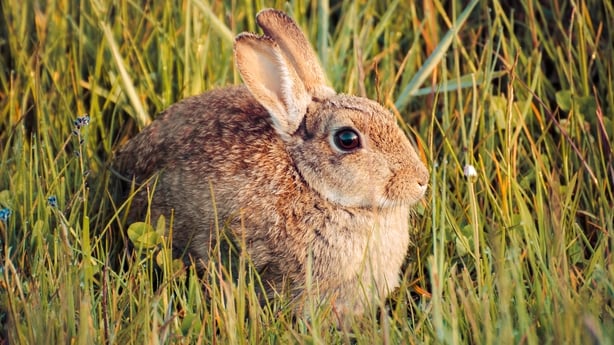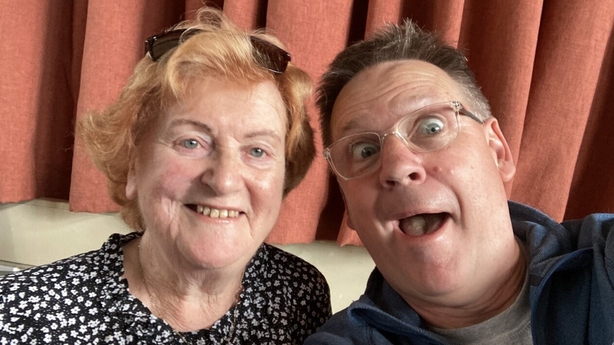To listen to RTÉ.ie's radio and podcast services, you will need to disable any ad blocking extensions or whitelist this site.

0
00:00
00:00
Episode Notes
Panel: Éanna Ní Lamhna & Niall Hatch. Reporter: Terry Flanagan. Interview: Richard Collins. In addition to listening to Mooney Goes Wild on RTÉ Radio One at 22:00 every Monday night, don't forget that you can also listen back to each of our programmes any time you like at www.rte.ie/mooney. There, you will find an extensive archive of past broadcasts, conveniently split into different topics and segments.
Our podcast pick this time around is last week’s interview with folklorist Shane Lehane, in which he chats to Richard Collins about how his deep interest in the Irish Hare led him to write a paper entitled The Cailleach and the Cosmic Hare, in which he fills us in on some of the striking folk beliefs that have sprung up around this mysterious and magical creature. You can listen back to this fascinating segment at https://www.rte.ie/radio/radio1/clips/22145252/
Do Buzzards pose a threat to Irish Hares?
Speaking of Irish Hares, we received an email during the week from listener John Grehan, who tuned in to our segment on last week's programme and has the following question for our panel:
I’m enjoying listening to the stories about the hare. Where I live in Co. Meath, hares have become rare, and I believe it coincides with the explosion in the Buzzard population. I wonder do others have the same opinion?
As Éanna and Niall explain on tonight’s programme, the sad decline in Irish Hares in Co. Meath and elsewhere may have occurred over much the same timeframe as the welcome recovery of Buzzards, but this does not mean that these two phenomena are linked. Buzzards like to hunt rabbits, certainly, but an adult Irish Hare is simply too large for them to tackle, and the young leverets are usually too well-hidden to be discovered by these highly visual predators. Both are native Irish species that evolved together and have co-existed side-by-side for millennia.
Instead, as is so often the case, it is we humans that have caused the downturn in the fortunes of the Irish Hare, as agricultural intensification, habitat destruction and illegal hunting, especially with dogs, have all taken their toll on these beleaguered mammals.

For more information about Irish Hares, visit https://iwt.ie/wp-content/uploads/2017/09/The-Irish-Hare.pdf
Avian Influenza: an update
Discussions about Highly Pathogenic Avian Influenza (HPAI), or 'bird ‘flu', have been growing more prominent in the media over the past week. It’s a subject that we have been covering for quite some time on Mooney Goes Wild, and on tonight’s programme we get an update on the current situation from Niall Hatch. As he tells us, BirdWatch Ireland has received literally hundreds of phone calls, emails and social media messages reporting dead and dying seabirds from all around the Irish coast, involving perhaps thousands of birds.
The Gannet appears to be the species that has been worst affected by this viral disease to date, but with thousands of migrant ducks, geese, swans and waders set to arrive in Ireland over the coming days and weeks, fears are growing that they, too, may suffer huge losses. There are also fears of significant impacts on the poultry industry and even on human health.
If you happen to come across a dead, dying or disorientated seabird over the coming weeks, the advice from the Department of Agriculture, Food and the Marine is not to handle it or try to assist it. Instead, you are asked please to report it to the department’s special Avian Check online portal or to call its Avian Influenza Hotline on 01-6072512.
To report any sightings of dead or unwell birds via the Department of Agriculture, Food and the Marine’s Avian Check portal, visit https://aviancheck.apps.rhos.agriculture.gov.ie/report
For more information about Gannets, visit https://birdwatchireland.ie/birds/gannet
What on Earth is a Basking Shark torus?
Fans of the popular Wordle game might learn a new potential answer, thanks to this week's programme. Recently, a torus (it’s in the Wordle database: we checked!) of Basking Sharks has been spotted off the west coast of Ireland. According to the Oxford English Dictionary, a torus is "a surface or solid formed by rotating a closed curve, especially a circle, about a line which lies in the same plane but does not intersect it (e.g. like a ring doughnut)."
But why would schools of the second-largest fish in the sea want to make doughnut shapes? Well, who better to tell us than long-standing Mooney Goes Wild contributor Dr. Simon Berrow, Chief Science Officer and Acting CEO of the Irish Whale and Dolphin Group? On tonight’s programme, Simon joins us from the Galway campus of the Atlantic Technological University, and explains that, apparently, it all boils down to courtship activity.
Despite the massive size of these ocean giants, remarkably little is known about their breeding behaviour. Simon explains how new technology being deployed both in and over Ireland’s offshore waters, which are of great international importance for Basking Sharks, has finally begun to change that.
Footage of 19 circling groups of Basking Sharks has been captured using underwater cameras and aerial drones off the Co. Clare coast between 2016 and 2021. This revealed that each group comprised between 6 and 23 sharks swimming slowly at the surface, with others circling deeper below them, forming a torus. Simon and his colleagues have co-authored a new scientific paper about these gatherings, which have previously been hidden from our gaze. As he tells us, each can be thought of as a "slow-motion speed-dating event".
To read this fascinating paper on Basking Shark breeding behaviour in full, visit https://onlinelibrary.wiley.com/doi/full/10.1111/jfb.15187
Celebrating Culture Night 2022 with a Swift one in Mountmellick
The Common Swift is a bird that is very close to our hearts here at Mooney Goes Wild, with Derek and Niall even having made a special documentary programme about these summer migrants to Irish skies. Despite the species' name, sadly it is no longer common across much of Ireland, with many former nesting colonies lost due to the demolition and redevelopment of the buildings in which they were once located.
On tonight’s programme, biologist and roving reporter Terry Flanagan travels to the town of Mountmellick, which hosts the largest breeding population of Swifts in Co. Laois, something of which the locals are rightly very proud.
There, he speaks to BirdWatch Ireland’s Ricky Whelan about an innovative artistic endeavour that aims to bring attention to these birds’ plight. As part of this week’s Culture Night festivities, artist James Kirwin is painting a Swift mural in the town to showcase these special avian visitors and to highlight efforts to save them through the installation of nesting boxes. It is due to be unveiled on Friday evening in what promises to be a unique celebration of biodiversity and culture.
For more information about the official unveiling of Mountmellick Swift Mural, visit https://culturenight.ie/event/launch-of-a-street-mural-in-mountmellick/
To listen back to our special Mooney Goes Wild documentary all about the Common Swift, visit https://www.rte.ie/radio/radio1/clips/22101533/
An Antarctic Affair: Fergus O'Gorman’s new book
Now, here’s a story you won’t hear every day. Fergus O’Gorman first set sail for the Antarctic in 1957, journeying to a hostile and barely-known continent. There, he spent three years studying fur seals, penguins, albatrosses and petrels, sometimes spending weeks alone in a tent in the midst of a seal colony. Indeed, he might be the only living Irish person to have wintered in the Antarctic.
Fergus has finally finished committing this remarkable tale to paper, in his first book An Antarctic Affair, which was published by The Harvest Press in August, some 46 years after it was started. On tonight’s programme, he speaks to Richard Collins from his home in Dalkey, Co. Dublin, about this journey of a lifetime, following in the footsteps of two other legendary Irishman, Ernest Shackleton and Tom Crean.
For more information about An Antarctic Affair and to purchase your own copy, visit https://www.theharvestpress.ie/product-page/antarctic-affair
Where have all the Robins gone?
Last Thursday, while hosting The Rose of Donnybrook for the senior citizens attending the Mary Aikenhead Day Centre in Donnybrook, Derek met volunteer keyboard player Lillian O'Connor from Drumcondra, who had a question about Robins for the Mooney Goes Wild panel. Lilian wanted to know why these charming little birds had apparently disappeared from her garden for the past couple of months, only to reappear suddenly in recent days? Had they perhaps been hibernating?
For more information about Robins, visit https://birdwatchireland.ie/birds/robin

Bog Café Arts & Eco Festival in Ardee
We have details of another wonderful Culture Night event to share with you. On tonight's programme, our researcher John Reilly brings us news of a wonderful arts & eco festival, hosted by the Bog Café in Ardee, Co. Louth. This event is being organised in conjunction with Friends of Ardee Bog, an environmental community group dedicated to protecting and preserving Ardee Bog, and will run from Friday 23rd to Monday 25th September.
A range of special events and activities are on the cards, including talks by Padraic Fogarty of the Irish Wildlife Trust, Peter Philips of BirdWatch Ireland and field recordist Dean McDonnell. There will also be workshops, poetry and lots of great music by Jinx Lennon, Sophie Coyle, Paul Callan and others. The festival is funded by the Arts Council.
For more information about the Bog Café Arts & Eco Festival, visit https://www.ardeebog.org/events
